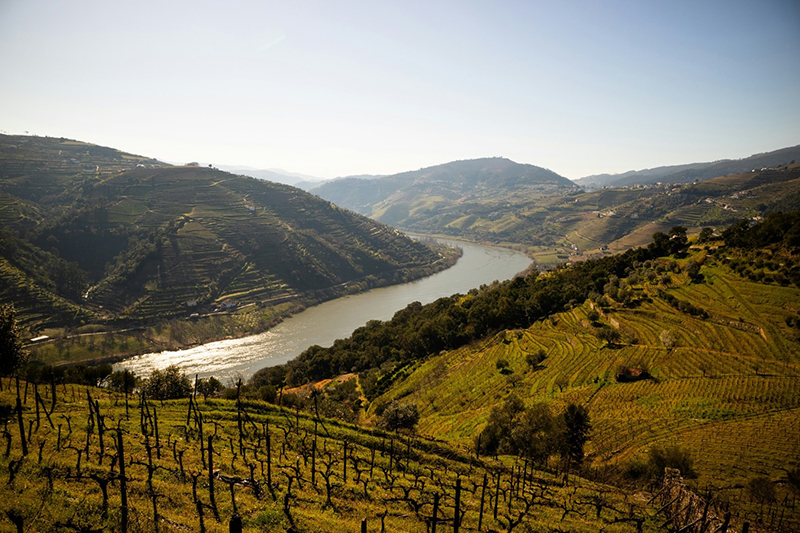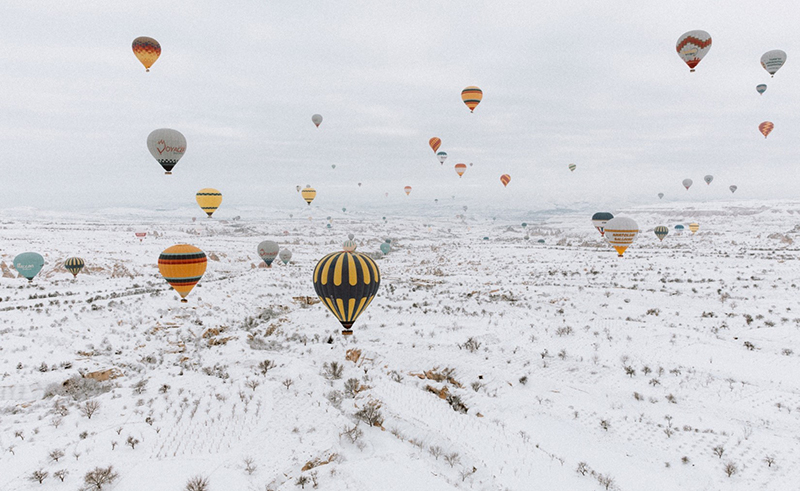POST
September 08 , 2024
5 Sunny Winter Destinations NOT in the Caribbean
Escape to these off-season hotspots for culture and adventure.

We might be headed into the cooler months, but that doesn’t mean you’ve missed the opportunity for a warm-weather vacation! In fact, many destinations are at their best during autumn and winter – the biggest perks of traveling after summer being minimal crowds and no scorching temperatures. Of course, you’ll avoid those peak season prices too.
Around the Mediterranean Sea and just to the west, where the Iberian Peninsula kisses the tip of northwest Africa, there have always been more sunny days in a year. The ‘shoulder season’ for travel in places like the Amalfi Coast and the Turkish Aegean seems to be creeping into October and even early November as the seasons shift later.
In Portugal, Spain, Türkiye, Egypt & Morocco, wintertime travel presents unique opportunities for some amazing experiences! Find out the unforgettable things you can do in each of these destinations …
Portugal: Surf, Sand and Golden Landscapes
Apart from presenting a more authentic side of the main touristic cities, the winter season in Portugal boasts some memorable activities.
Big Waves
Portugal is renowned for its winter surf scene, especially in places like Nazaré, where you can watch some of the world’s highest waves roll in. If you’re lucky, you might witness the ‘Big Wave Challenge’, which is open to spectators, but throughout the winter you can probably spot some surfers catching massive swells in Nazaré. Continuing south, Peniche, Ericeira and Sagres also attract surfers from around the world.

Photo by Tiago Ferreira on Unsplash
Coastal Retreats
In the south of Portugal, the Algarve is a year-round zone for sun and sand on the Atlantic. This special region is recognized by its striking honey-colored cliffs and sea arches. The beaches are much more serene after the summer crowds have dissipated. You can even go up along the cliffs for scenic hiking around Ponta da Piedade and Praia da Marinha, or take coastal walks between small villages like Salema and Burgau. The historic centers of Albufeira, Faro, Olhao and more add a dose of culture for a beach holiday that’s anything but bland.

Photo by Artem Zhukov on Unsplash
Valley Vineyards
The cooler months bring a beautiful amber hue to the vineyards that climb the Douro Valley’s terraced hillsides. Enjoy the effect with a boat ride along the Douro River and sample the varied wines at one of the well-known ‘quintas’. The grape harvest typically begins in mid-September to early October, so you could even pitch in if the timing is right. Take a day trip from Porto or spend the night in a wine lodge. For a bit of romance, there’s nothing quite like cozying up to a bottle of wine and a fireplace as you look out over the grape vines.

Photo by Eduardo Lages on Unsplash
Canary Islands: From Sunny Days to Bright Nights
It’s summer all year long in the Canaries, an ideal destination to chase the winter sun.
Inviting Beaches
A collection of eight volcanic islands off the coast of Morocco, Spain’s Canary Islands have steady temperatures from the mid 60s to mid 70s no matter what season you choose to visit. The waters are crystal-clear and welcoming for all types of water activities like swimming, snorkeling, paddleboarding, windsurfing, and even spotting whales and dolphins.

Photo by Oleksandr P on Pexels
Bright Stars
The Canary Islands possess some of the best stargazing conditions in Europe. With their remote location in the Atlantic, high mountain peaks and low light pollution, the clear skies provide breathtaking views of stars and constellations. Visitors can take a tour of the Roque de los Muchachos Observatory on La Palma or Teide Observatory on Tenerife, both set within internationally recognized dark sky reserves. Winter skies are often clearer for an even more incredible experience!

Photo by Xavier Mestdag on Pexels
Colorful Celebrations
In February, the islands get even brighter with Santa Cruz de Tenerife’s Carnival. This happens to be the the second-largest carnival festival in the world (after Rio de Janeiro). The bold, extravagant parades feature elaborate costumes and hundreds of musical acts and dance troupes. If you want to participate in this massive street party, you’ll need to plan well in advance as accommodations fill up quickly.

Photo on Pixabay
Türkiye: Sun-Kissed Coast Meets Timeless Traditions
Türkiye in the off-season means cozy traditions, pleasant days in seaside towns, and hushed historic sights.
Scenic Ruins
The cooler months provide a nice chance to commune with ancient stones in a more serene setting. The southern region from Bodrum to Fethiye to Antalya has an incredible amount of ruins in the most beautiful natural surroundings of pine forest and brilliant blue sea. In the summertime Antalya is especially unbearable, but when high temps slack off from September to November, it becomes ideal for exploring. Adventurous visitors can walk part of the Lycian Way long-distance hiking trek, and a dip in the sea is not out of the question either.

Photo by Erik Karits on Pexels
Fairytale Landscapes
In Cappadocia, balloon-filled skies combine with strange rock formations and pinnacles called ‘fairy chimneys’ to create a surreal backdrop any time of year. This is another fun hiking destination, and you can take advantage of cool-weather months to really explore the multi-colored valleys and all the hidden churches and caves tucked into the ridges. There are trails for inexperienced hikers, but it can be good to have a guide to help you find your way as the trail markers aren’t always clear. In the winter, the snow-dusted landscape makes an even more magical picture. Just an hour from Cappadocia, closer to the Kayseri Airport, you’ll find the ski slopes of Mt. Erciyes for an easy way to add some snow sports to your trip.

Photo by Maksym Mazur on Unsplash
Warming Rituals
If you get caught on a wet winter day in Istanbul, then you can warm up your muscles and pamper your skin with a visit to a traditional Turkish hamam. No matter what city you’re in, you’ll be able to find a Turkish bath. You can also take off the chill with a cup of Turkish tea, as you will invariably be offered a cup of çay (chai) wherever you go. Another special hot drink is salep, a thick sweet beverage that comes from the precious powder of orchid tubers boiled with milk. Spiced with a sprinkle of cinnamon and ginger, it’s something unique to taste and take home with you!

Photo by Engin Akyurt on Pexels
Egypt: Go Under the Sea and Down the Nile
If you’ve ever considered flying off to the Bahamas for winter, but you also want a good mix of history and culture, then Egypt is for you.
Beach Resorts
The Red Sea has some of the warmest waters you’ll find in the Northern Hemisphere during the colder months, good for swimming and water sports. Fly into Hurghada from Cairo (or have a private transfer from Luxor) and leave with a tan. The marine life of the Red Sea is legendary, and October to December are perfect for diving and snorkeling. The water temperature around resorts like Sharm el Sheikh and Dahab stays above 75°F (you’ll still want a wet suit for dives), then drops in January. Winter typically brings better visibility to spot plenty of sea creatures.

Photo by Freesally on Pixabay
Black & White Deserts
Experience Egypt like you never dreamed with an adventure into some of the more unique quarters of the Sahara Desert around White Desert National Park. The cooler winter climate makes for delightful desert camping, hiking, and exploring the fascinating rock formations. Take a desert safari from Cairo to discover the lush palm groves and hot springs of the Bahariya Oasis and spend a truly memorable night under the stars.

Photo by Amira Shawky on Unsplash
Ancient Sites
It shouldn’t go unsaid that off-season months are significantly more comfortable for walking around the incredible ancient Egyptian pyramids, temples and cities of the dead. Daytime temperatures in Cairo can still get up to 80°F in the autumn, while in the winter the average high is in the mid 60s. You’ll be even more thankful for the temperature drop as you head south to Aswan, where it can be over 100°F in the summer. Cruise down the Nile, admire the riverside temples and villages, and soak up the friendly sunshine.

Photo by AXP Photography on Unsplash
Morocco: From Desert Dunes to Snow-Capped Peaks
All the way on the other side of the Sahara, Morocco combines winter sun with Berber culture, adventure activities and simmering marketplaces.
Camel Rides
If you visit Morocco in the winter, you have to ride a camel over the dunes to a desert camp and take your dinner Bedouin style, by the fire and under the stars. It’s definitely a smart idea to do this in the months when daytime temperatures are cooler, but of course keep in mind that it does get chilly at night. You will leave with a lasting impression left by the warm people and the supreme majesty of nature.

Photo by Boris Ulzibat on Pexels
Atlas Mountains
The High Atlas Mountains can provide an interesting contrast to your Morocco desert expedition. There is the possibility to ski at one of the resorts on Mt Toubkal, the highest peak in northern Africa. If you really love hiking, then autumn is the best time to go. Stay at a luxurious retreat in the Ouirgane Valley or try a cozy guesthouse to immerse yourself in a local Berber village.

Photo by Saara Sanamo on Unsplash
Imperial Cities
The slower tourist season makes for a more inviting time to walk the streets of Marrakech, Casablanca, Rabat and Fez. The historic medinas and imperial sites are not so crowded, so you can have a more relaxing stroll even as the sellers shout their typical encouragements to try this and buy that. After a day on your feet exploring plush palaces and museums, come back to relax in your beautiful riad (traditional guesthouse with inner courtyard) or luxury hotel with hammam.

Photo by Niklas Schweinzer on Unsplash
The best time to start planning your next getaway is now, and we’re excited to help you dream up a trip to one of these extraordinary destinations.